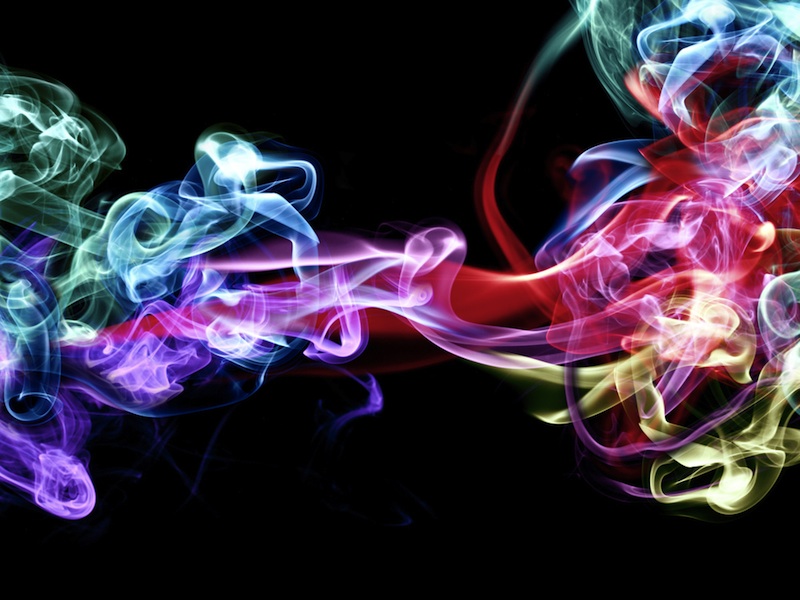Active Ingredient in Ayahuasca Tea Puts Brain in a Dream-Like State
Trippy things happen in the brain after drinking psychedelic tea.

The active ingredient DMT in the psychedelic tea ayahuasca causes a dream-like state in the brain, new research finds.
After a dose of the drug DMT (short for dimethyltryptamine), people's brain waves slip into a rhythm of delta and theta waves that looks much like the brain waves of rapid-eye-movement (REM) sleep — the phase of sleep where the most vivid dreams occur. At the same time, people report immersive dream-like experiences, ranging from the perception that they are enmeshed in a field of geometric shapes to the notion that they are communicating with mysterious entities.
"We found a nice parallel between what happened in the DMT experience and the dream experience," said Christopher Timmermann, a doctoral candidate at the Centre for Psychedelic Research at Imperial College London.
Related: Trippy Tales: The History of 8 Hallucinogens
This parallel could help explain why people often find psychedelic experiences so personally meaningful, and it could ultimately lead to new treatments for psychiatric disorders.
Psychedelic experience
DMT is a natural psychedelic from the chacruna shrub (Psychotria viridis). Along with the vine (Banisteriopsis caapi), the shrub is one of the ingredients in ayahuasca tea, a traditional brew from the Amazon basin. While ayahuasca tea is imbibed by drinking, DMT alone is often smoked.
Timmermann and his colleagues were interested in studying DMT because people who use it often report feeling "completely and radically immersed" in an alternative world, he said. Users often experience significant emotions within this altered reality and attribute great meaning to the experience. Studies have even shown that the DMT "high" shares similarities with near-death experiences.
Sign up for the Live Science daily newsletter now
Get the world’s most fascinating discoveries delivered straight to your inbox.
"It feels more real than real," Timmermann told Live Science.
To find out what happens in the brain to create these feelings, the researchers asked six women and seven men to take a dose of DMT while getting an electroencephalogram (EEG) to measure their brain waves. EEGs use noninvasive electrodes on the scalp to capture electrical activity in the brain. Each participant had two EEG sessions: one in which the person received an intravenous dose of real DMT and one in which the individual got a placebo of saline.
Waking dreams?
Intravenous DMT is fast-acting and short-lived. The participants began to notice the effects as a rush of warmth and a feeling of expansion almost immediately; but in 20 minutes, the dose had worn off. As the drug took effect for the participants, Timmermann and his colleagues measured three notable brain-wave changes. The first was a decrease in alpha waves, which are regular oscillations in brain activity that are most common when the brain is in a conscious, resting state. Decreases in alpha waves have been seen in people under the influence of other psychedelics, such as LSD and psilocybin, Timmermann said.
Related: 11 Odd Facts About Magic Mushrooms
The brain on DMT also starts to produce rhythmic oscillations of delta and theta waves, which have greater amplitude and slower frequency than alpha waves. The alternating pattern of delta and theta waves mimics what happens during REM sleep.
Meanwhile, overall electrical activity in the brain became more unpredictable when the person was on DMT, Timmermann said. This is another effect that has been seen with other psychedelic drugs. It's also the opposite of what happens during deep, dreamless sleep or comas, when brain activity becomes extremely predictable.
This "is interesting because it postulates this potential idea that psychedelics might be increasing consciousness, if you will," Timmermann said.
The researchers also asked participants to report their experiences minute by minute during the 20 minutes that the DMT was active in their systems. These subjective reports tracked with the intensity of the brain-wave changes. For example, as alpha waves declined and brain-wave unpredictability increased, people reported their hallucinogenic experiences becoming more intense.
What's not yet clear is why psychedelics like DMT often create such intense, meaningful emotional experiences in users. Some research has found that structures in the brain that are involved in emotion, like the amygdala and the hippocampus, are affected by psychedelics, Timmermann said, but more research is needed.
He and his colleagues now plan to use functional magnetic resonance imaging (fMRI) to study more closely what the different brain regions do when exposed to DMT. They also hope to increase the length of people's DMT trips in order to study the drug's effects over time periods longer than 20 minutes. This research could help explore the therapeutic potential of DMT and reveal whether it might have potential as a possible pharmaceutical for mental illness.
"Physiologically, DMT is very safe and the toxicity profile is quite good," Timmermann said. "The only caveat is that people can have strong psychological experiences when they take it in unsupervised contexts."
- 7 Mind-Bending Facts About Dreams
- Senses and Non-Sense: 7 Odd Hallucinations
- Scientists Analyze Drawings by an Acid-Tripping Artist
Originally published on Live Science.


Stephanie Pappas is a contributing writer for Live Science, covering topics ranging from geoscience to archaeology to the human brain and behavior. She was previously a senior writer for Live Science but is now a freelancer based in Denver, Colorado, and regularly contributes to Scientific American and The Monitor, the monthly magazine of the American Psychological Association. Stephanie received a bachelor's degree in psychology from the University of South Carolina and a graduate certificate in science communication from the University of California, Santa Cruz.









